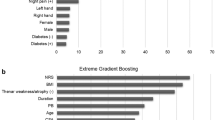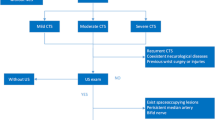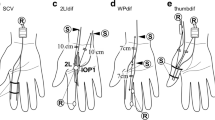Abstract
This paper presents the use of recurrent neural networks (RNNs) for diagnosis of carpal tunnel syndrome (CTS) (normal, right CTS, left CTS, bilateral CTS). The RNN is trained with the Levenberg-Marquardt algorithm. The RNN is trained on the features of CTS (right median motor latency, left median motor latency, right median sensory latency, left median sensory latency). The multilayer perceptron neural network (MLPNN) is also implemented for comparison the performance of the classifiers on the same diagnosis problem. The total classification accuracy of the RNN is significantly high (94.80%). The obtained results confirmed the validity of the RNNs to help in clinical decision-making.




Similar content being viewed by others
References
Bland, J. D., Carpal tunnel syndrome. BMJ. 335:343–346, 2007. doi:10.1136/bmj.39282.623553.AD.
Aroori, S., and Spence, R. A., Carpal tunnel syndrome. Ulster Med. J. 77:6–17, 2008.
Preston, D. C., and Shapiro, B. E., Electromyography and neuromuscular disorders. Elsevier Science, Philadelphia, pp. 255–281, 2005.
Haykin, S., Neural networks: A Comprehensive Foundation. Macmillan, New York, 1994.
Basheer, I. A., and Hajmeer, M., Artificial neural networks: fundamentals, computing, design, and application. J. Microbiol. Methods. 43 (1)3–31, 2000. doi:10.1016/S0167-7012(00)00201-3.
Chaudhuri, B. B., and Bhattacharya, U., Efficient training and improved performance of multilayer perceptron in pattern classification. Neurocomputing. 34:11–27, 2000. doi:10.1016/S0925-2312(00)00305-2.
Miller, A. S., Blott, B. H., and Hames, T. K., Review of neural network applications in medical imaging and signal processing. Med. Biol. Eng. Comput. 30:449–464, 1992. doi:10.1007/BF02457822.
Mobley, B. A., Schechter, E., Moore, W. E., McKee, P. A., and Eichner, J. E., Predictions of coronary artery stenosis by artificial neural network. Artif. Intell. Med. 18:187–203, 2000. doi:10.1016/S0933-3657(99)00040-8.
Übeyli, E. D., Comparison of different classification algorithms in clinical decision-making. Expert Syst. 24 (1)17–31, 2007. doi:10.1111/j.1468-0394.2007.00418.x.
Übeyli, E. D., Analysis of EEG signals by combining eigenvector methods and multiclass support vector machines. Comput. Biol. Med. 38 (1)14–22, 2008. doi:10.1016/j.compbiomed.2007.07.004.
Übeyli, E. D., Combining neural network models for automated diagnostic systems. J. Med. Syst. 30 (6)483–488, 2006. doi:10.1007/s10916-006-9034-z.
Übeyli, E. D., A mixture of experts network structure for breast cancer diagnosis. J. Med. Syst. 29 (5)569–579, 2005. doi:10.1007/s10916-005-6112-6.
Übeyli, E. D., Multiclass support vector machines for diagnosis of erythemato-squamous diseases. Expert Syst. Appl. 35 (4)1733–1740, 2008. doi:10.1016/j.eswa.2007.08.067.
Übeyli, E. D., Modified mixture of experts for diabetes diagnosis. J. Med. Syst. 2009 (in press).
Übeyli, E. D., Adaptive neuro-fuzzy inference systems for automatic detection of breast cancer. J. Med. Syst. 2009 (in press)
Übeyli, E. D., and Doğdu, E., Automatic detection of erythemato-squamous diseases using k-means clustering. J. Med. Syst. 2009 (in press)
Übeyli, E. D., İlbay, K., İlbay, G., Sahin, D., and Akansel, G., Differentiation of two subtypes of adult hydrocephalus by mixture of experts. J. Med. Syst. 2009 (in press).
Elman, J. L., Finding structure in time. Cogn. Sci. 14 (2)179–211, 1990.
Übeyli, E. D., Recurrent neural networks employing Lyapunov exponents for analysis of Doppler ultrasound signals. Expert Syst. Appl. 34 (4)2538–2544, 2008. doi:10.1016/j.eswa.2007.04.002.
Übeyli, E. D., Recurrent neural networks with composite features for detection of electrocardiographic changes in partial epileptic patients. Comput. Biol. Med. 38 (3)401–410, 2008. doi:10.1016/j.compbiomed.2008.01.002.
Übeyli, E. D., Analysis of EEG signals by implementing eigenvector methods/recurrent neural networks. Digit. Signal Process. 19 (1)134–143, 2009. doi:10.1016/j.dsp.2008.07.007.
Übeyli, E. D., Combining recurrent neural networks with eigenvector methods for classification of ECG beats. Digit. Signal Process. 19 (2)320–329, 2009. doi:10.1016/j.dsp.2008.09.002.
Übeyli, E. D., and Übeyli, M., Case studies for applications of Elman Recurrent Neural Networks, Recurrent Neural Networks, I-Tech Education and Publishing, Editors: Xiaolin Hu, P. Balasubramaniam, ISBN 978-953-7619-08-4, Chapter 17, pp. 357–376, 2008.
Budak, F., Yenigun, N., Ozbek, A., et al., Carpal tunnel syndrome in carpet weavers. Electromyogr. Clin. Neurophysiol. 41:29–32, 2001.
Pineda, F. J., Generalization of back-propagation to recurrent neural networks. Phys. Rev. Lett. 59 (19)2229–2232, 1987. doi:10.1103/PhysRevLett.59.2229.
Battiti, R., First- and second-order methods for learning: between steepest descent and Newton’s method. Neural Comput. 4:141–166, 1992. doi:10.1162/neco.1992.4.2.141.
Hagan, M. T., and Menhaj, M. B., Training feedforward networks with the Marquardt algorithm. IEEE Trans. Neural Netw. 5 (6)989–993, 1994. doi:10.1109/72.329697.
Author information
Authors and Affiliations
Corresponding author
Rights and permissions
About this article
Cite this article
Ilbay, K., Übeyli, E.D., Ilbay, G. et al. Recurrent Neural Networks for Diagnosis of Carpal Tunnel Syndrome Using Electrophysiologic Findings. J Med Syst 34, 643–650 (2010). https://doi.org/10.1007/s10916-009-9277-6
Received:
Accepted:
Published:
Issue Date:
DOI: https://doi.org/10.1007/s10916-009-9277-6




